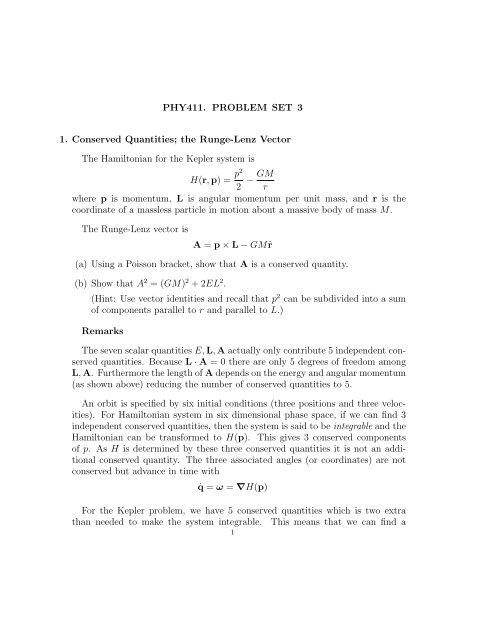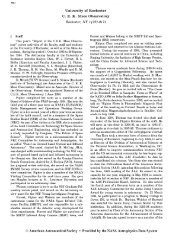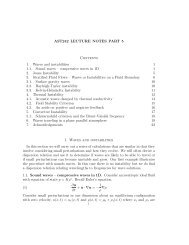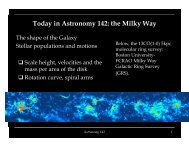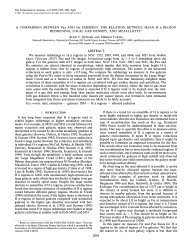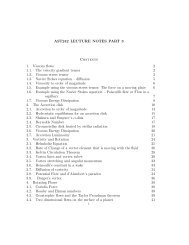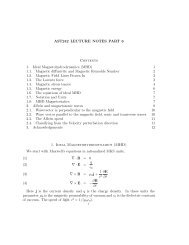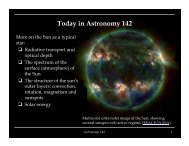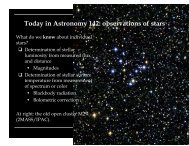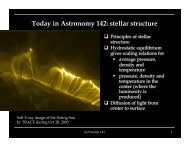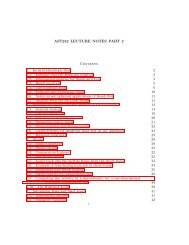PHY411. PROBLEM SET 3 1. Conserved Quantities - Astro Pas ...
PHY411. PROBLEM SET 3 1. Conserved Quantities - Astro Pas ...
PHY411. PROBLEM SET 3 1. Conserved Quantities - Astro Pas ...
- No tags were found...
You also want an ePaper? Increase the reach of your titles
YUMPU automatically turns print PDFs into web optimized ePapers that Google loves.
<strong>PHY41<strong>1.</strong></strong> <strong>PROBLEM</strong> <strong>SET</strong> 3<strong>1.</strong> <strong>Conserved</strong> <strong>Quantities</strong>; the Runge-Lenz VectorThe Hamiltonian for the Kepler system isH(r, p) = p22 − GM rwhere p is momentum, L is angular momentum per unit mass, and r is thecoordinate of a massless particle in motion about a massive body of mass M.The Runge-Lenz vector isA = p × L − GMˆr(a) Using a Poisson bracket, show that A is a conserved quantity.(b) Show that A 2 = (GM) 2 + 2EL 2 .(Hint: Use vector identities and recall that p 2 can be subdivided into a sumof components parallel to r and parallel to L.)RemarksThe seven scalar quantities E, L, A actually only contribute 5 independent conservedquantities. Because L · A = 0 there are only 5 degrees of freedom amongL, A. Furthermore the length of A depends on the energy and angular momentum(as shown above) reducing the number of conserved quantities to 5.An orbit is specified by six initial conditions (three positions and three velocities).For Hamiltonian system in six dimensional phase space, if we can find 3independent conserved quantities, then the system is said to be integrable and theHamiltonian can be transformed to H(p). This gives 3 conserved componentsof p. As H is determined by these three conserved quantities it is not an additionalconserved quantity. The three associated angles (or coordinates) are notconserved but advance in time with˙q = ω = ∇H(p)For the Kepler problem, we have 5 conserved quantities which is two extrathan needed to make the system integrable. This means that we can find a1
2 <strong>PHY41<strong>1.</strong></strong> <strong>PROBLEM</strong> <strong>SET</strong> 3coordinate system such that H(Λ) only depends on a single momentum. In thiscoordinate system two associated coordinates or angles are conserved, as well asthree momenta. The system is said to be ”super-integrable”.The conservation of L implies that the Lie group of symmetries contains SO(3).Including the Runge-Lenz vector, the Lie algebra is equivalent to that of SO(4).The additional symmetry is related to a continuous transformation that maps anorbit to one with a different angular momentum while preserving energy. The Liealgebra is the Poisson algebra obeyed by the Poisson brackets and is comprised ofinfinitesimal transformations. The Lie group is the entire continuous symmetrygroup. It is possible to have different Lie groups that have the same algebra fortheir infinitesimal transformations.2. Periodically forced pendulumWe will integrate the equations of motion for the time dependent system,H(p, φ, t) = p22− ɛ cos φ − µ cos(φ − νt) (1)to make a map g T from phase space φ, p to itself at a time T laterWe will useφ(t), p(t)g T−−→ φ(t + T ), p(t + T )T = 2π/νthe period of the time dependent perturbation in the Hamiltonian, to create themap.Starting with an initial condition x 0 = (p 0 , φ 0 ) we can iteratively apply thismap. The orbit of an initial condition is the collection of pointsg T (x 0 ), g 2T (x 0 ), g 3T (x 0 )....The orbits of the map are curves, points or area filling regions.Our map is a function of parameters ν, ɛ, µ. The Hamiltonian has two resonances,one at p = 0 and the other at p = ν. The two resonances are separated bya frequency ν. The peaks of the separatrices for one resonance are at p = ±2 √ |ɛ|and the other at p = ±2 √ |µ|. Thus the resonances are overlapped if2 √ |ɛ| + 2 √ |µ| < ν (2)
<strong>PHY41<strong>1.</strong></strong> <strong>PROBLEM</strong> <strong>SET</strong> 3 3There is a sample python code “perio.py” illustrating how to to use the pythonroutine odeint to integrate the Hamiltonian, make the map and apply it iteratively.http://astro.pas.rochester.edu/ aquillen/phy411/pylab/perio.pyBy using different initial conditions (shown in different colors) a picture of thetypes of different orbits can be constructed; see Figure 1Figure <strong>1.</strong> Mapping at a period for the Hamiltonian in equation 1with ν = 2, ɛ = 0.4, µ = 0.15.(a) Chose µ, ɛ, ν so that the resonances do not overlap (check condition 2). Integratethe map and plot some orbits. When the resonances do not overlap,show that most initial conditions give orbits that are curves.(b) Chose µ, ɛ, ν so that the resonances do overlap. Integrate the map and plotsome orbits. When the resonances overlap, show that some initial conditionsgive orbits that are area filling. These orbits are likely to be in regions nearthe separatrix of one of the resonances.(c) Explore different parameters to see if you can find periodic orbits (threeresonant islands corresponding to period three orbits). If you look closely
4 <strong>PHY41<strong>1.</strong></strong> <strong>PROBLEM</strong> <strong>SET</strong> 3at Figure 1 there are some period 7 orbits at the edge of the lower stableresonant island.(d) Explore how the width (in p) of the area filling region depends on the valuesof ν/ √ ɛ and µ/ɛ.(e) Consider a phase shift caused by a constant φ 0H(p, φ, t) = p22 − ɛ cos φ − µ cos(φ − νt − φ 0)How does this change the map?3. On the restricted 3-body problemThe dynamics of a massless particle in orbit near two massive bodies is givenby HamiltonianH(x, y; p x , p y ) = 1 2 (p2 x + p 2 y) −1 − µ√(x − µ)2 + y 2 − µ√(x + (1 − µ))2 + y 2 − (xp y − yp x )where we have restricted the dynamics to the plane containing the two massivebodies and we have assumed that the two massive bodies are circular orbits aboutthe center of mass. The above Hamiltonian is in the center of mass coordinatesystem that is rotating with the two massive bodies, so they remain in fixedpositions. Here µ ≡ m 2m 1 +m 2where m 1 , m 2 are the masses of the two bodies. Weare working in units of distance between m 1 and m 2 and in units of time andmass so that G(m 1 + m 2 ) = <strong>1.</strong> The above Hamiltonian is independent of time soenergy is conserved. The conserved quantity is known as the Jacobi integral ofmotion, E J .In polar coordinates the system is equivalent toH(r, θ; p r , L) = p2 r2 + L22r 2 −L− 1 − µ√µ2 + r 2 − 2rµ cos θ − µ√(1 − µ)2 + r 2 + 2(1 − µ)r cos θ(a) Suppose that we take into account the z degree of freedom. What is theHamiltonian H(x, y, z; p x , p y , p z )?(b) Consider an orbit that is nearly circular with radius r c . What is its valueof L? What is its value of energy E J ( (the value of H)? In other wordswhat is L(r c ) and E J (r c )? You can assume that µ is very small to do thisestimate so that the second potential term can be neglected and the first canbe approximated as −1/r.
<strong>PHY41<strong>1.</strong></strong> <strong>PROBLEM</strong> <strong>SET</strong> 3 5Hint: To solve for L(r c ) use Hamilton’s equation ṗ r = ∂H = 0. To check∂ryour answer, consider how angular momentum depends on radius for circularorbits in a Keplerian system.If you are making a surface of section, it useful to know where to expectnearly circular orbits. You can choose E J so that you will see nearly circularorbits near a desired radius.When µ is not small, then one can manipulate the average value of thepotential using a function g(α)∫ 2π( )dθ2α2g(α) = √1 − α2 cos θ = 4K (1 + α 2 ) −1/2 (3)α 2 + 10where the complete elliptic integral of the first kind K(k) is defined asK(k) =∫ π/20dθ√1 − k2 sin 2 θFor the nearly circular orbit case we can take r to be constant and replace1 − µV (r, θ) = −√ µ2 + r 2 − 2rµ cos θ − µ√(1 − µ)2 + r 2 + 2(1 − µ)r cos θwithV 0 (r) = 1 ∫ []2π1 − µdθ −√ 2π 0 µ2 + r 2 − 2rµ cos θ − µ√(1 − µ)2 + r 2 + 2(1 − µ)r cos θ( )( )(1 − µ) 2rµ= − √µ2 + r g µ2r(µ − 1)− √ 2 µ 2 + r 2 (1 − µ)2 + r g 2 (1 − µ) 2 + r 24. On Periodic OrbitsConsider orbits described by three angles. The azimuthal angle θ, radial oscillationangle θ r and vertical oscillation angle θ z . The radius and vertical heightare related to action variables J r and J z withr = r c + √ 2J r /κ cos θ rz = √ 2J z /ν cos θ zwhere the epicyclic frequency is κ = ˙θ r and the vertical oscillation frequency isν = ˙θ z .(a) Draw a closed or periodic orbit with φ = θ r −2θ = 0 and with φ ′ = θ z −2θ = 0.What does look orbit look like in the xy plane, xz plane and in the yz plane?
6 <strong>PHY41<strong>1.</strong></strong> <strong>PROBLEM</strong> <strong>SET</strong> 3(b) Draw a closed or periodic orbit with φ = θ r −2θ = π and with φ ′ = θ z −2θ = 0.One of these types of orbits is called banana shaped.5. On Creating a Map for a separable Hamiltonian with the Dirac CombSuppose we have a separable HamiltonianThe equations of motionH(p, q) = P (p) + Q(q)ṗ = − ∂H∂q = −∂Q ∂q˙q = ∂H∂p = ∂P∂pOver a small time τ∆p = ṗτ = − ∂Q∂q τWe can approximate the equations of motion using the Hamiltonianwhere D τ is the Dirac comb orH(p, q, t) = P (p) + Q(q)τD τ (t) (4)D τ =∞∑n=−∞Denote p n , q n as p, q at times t = nτ.δ(t + nτ)(a) Create a map for p n+1 and q n+1 as a function of p n , q n that is consistent withthe equations of motion for the approximate Hamiltonian in equation 4.(b) Show that your map is area preserving.Hint: Because H is independent of q between delta functions, p is conservedand only changes at times t = nτ. The Hamiltonian implies that ˙q is constant attimes other than t = nτ.


